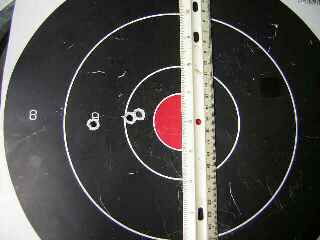(Click here for the first SKS article.)
(Click here for the second SKS article.
(Click here for the third SKS article.
Copyright June 2014 by Junior Doughty
Click some photos for full size
photos
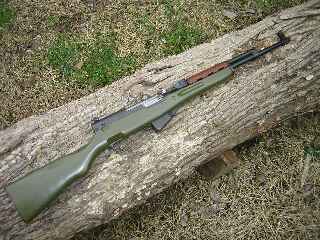 A not-so-funny thing happened back in February after I finished the weight loss program on the SKS shown here. It jammed while being charged by a beer can. Had the beer can been a North Louisiana wild boar hog, you wouldn't be reading this article. Thus began an extensive project to find the cause of the jam and fix it. A not-so-funny thing happened back in February after I finished the weight loss program on the SKS shown here. It jammed while being charged by a beer can. Had the beer can been a North Louisiana wild boar hog, you wouldn't be reading this article. Thus began an extensive project to find the cause of the jam and fix it.
After many wasted 181 gr fat 311041 cast bullets, beaucoup primers, and lots of my scant supply of surplus 4895 powder, the evidence was—an ejection jam every 15 rounds or so. During the discovery process, I began shooting single shot, i.e., load one round and shoot it. Repeat, repeat. I discovered that the bolt didn't lock back about 1/3 of the time. Now that was something radically different. It had never happened before. The thought struck me that WWII gunpowder didn't have modern coatings to eliminate temperature sensitivity. It was warm September when I last shot the SKS, and it functioned perfectly. It was now cold February, and suddenly my WWII 4895 wasn't generating enough pressure to fully cycle the action.
If you push the bolt/carrier backwards, to the right, the first yellow arrow, the skinny one, marks the bolt travel point where the fired case ejects. The second yellow arrow, the fatter one, marks the bolt travel point where the bolt locks back. So a fired round wasn't generating enough gas pressure to force the bolt/carrier far enough to the rear. The fired case was either just barely clearing or barely not clearing the action when the bolt slammed forward. In fact, the bolt didn't have close to enough rearward travel. The red arrow marks the point of maximum bolt rearward travel. The result = a jammed ejected case when it didn't clear the action before the closing bolt hit it.
So fix it, Junior!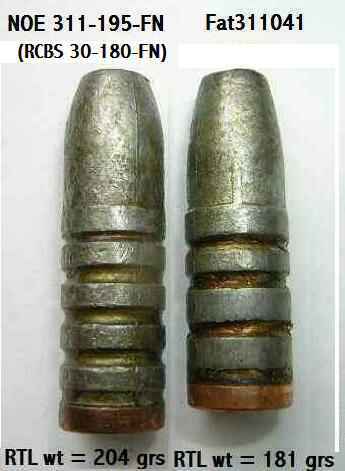 Easier said than done!
Easier said than done!I began with the obvious—give the fat 311041 more velocity, i.e., more pressure. But more velocity brings up a cast bullet boogerbear—more velocity means more RPMs. In the case of this 9.5 twist SKS and bullets cast with my reclaimed shot alloy or my wheelweight alloy, if I pushed those cast bullets over about 130,000 rpms or circa 1750 fps, they gave patterns, not groups. Like miss a 5-gallon bucket groups @ 30 yards. So, many more scarce components went downrange and up in smoke. I tried all the suitable powders I had on hand. That included H4198 (which gave high presssure signs at only 1600 fps), Accurate 2015, Varget and surplus 4895. None gave accuracy with pressure levels which reliably locked the bolt back. So I turned to a heavier bullet—the RCBS 30-180-FN. I had some on hand I cast years ago from wheelweight alloy. They were lubed and sized .310" in my Lyman 450. They weighed 197 grs RTL. I had lubed them in my Lyman 450 with my own lube concoction. I call it "411" or "Pinko Commie Fag" lube. It's 4 parts beeswax, 1 part Dexron transmission fluid and 1 part plain ol' lithium auto grease. (I haven't used it or the Lyman 450 since I discovered Lee Liquid Alox.) That ancient 197 gr bullet and its pink lube gave fine results. I kept it circa 1700 fps for the RPM factor and received perfect bolt lock back, no pressure signs and good accuracy, i.e., beer cans @ 30 yards instead of missed 5-gallon buckets @ 30 yards. My jug of 197 gr RCBS bullets began dwindling down to the need-to-cast-more level. But I don't like iron molds for several reasons. And I don't like 2-cavity molds for an obvious reason.
My NOE 311-195gr-FN mold casts a reclaimed shot alloy, RTL 204 gr bullet. I twice lubed them with Lee Liquid Alox and sized them .312" in a custom Lee push-through sizer. Think about that—a 204 gr bullet from an SKS! Mister Big Bad Boar Hog doesn't have a chance! As you can see, I put a slight roll crimp in the first lube groove below the crimp groove. A roll crimp ensures that recoil won't pull out the bullet from a round in the magazine. Yes, the gas check sticks below the case neck bottom. I have never had a problem with that. The gas check might pull off the bullet shank and stay in the case if I were to pull the bullet, but not upon firing. Did I hear you ask, Why? Because gas pressure pushes against the bottom of the gas check; that's why. It might come off outside the case and barrel when the pressure drops to atmospheric pressure, but at 30,000+ psi inside the case and barrel, the gas check stays put.
Compared to a 2-cavity mold, a 4-cavity mold literally spits out bullets. And an aluminum mold will cast a pile of good bullets before an iron mold gets hot enough to cast one good bullet. Lee 6-cavity handles fit NOE BULLET MOLDS with slight modification needed, maybe. Or you can order handles from NOE BULLET MOLDS. You might have to run a file down the side of one Lee handle to make a perfect fit. I did. It took maybe 15 seconds. My Full Length Resized WW cases will hold a compressed maximum of 1.8cc of powder under a 204 gr NOE 311-195-FN bullet seated in the 1st lube groove beneath the normal crimp groove. You can squeeze more in the case via heavy compression with a heavy roll crimp. But you take a high risk of bullet pull due to recoil combined with heavy powder compression. Don't do it! The 204 gr NOE bullet has a 60% greater Sectional Density @ ~ .299 than a normal 124 gr SKS bullet @ ~ .182. I believe it would penetrate 2 normal wild boars standing side by side, even at 1700 fps muzzle velocity. Plus, my SKS's magazine holds 10 of them. That's truly bad boar medicine.
|
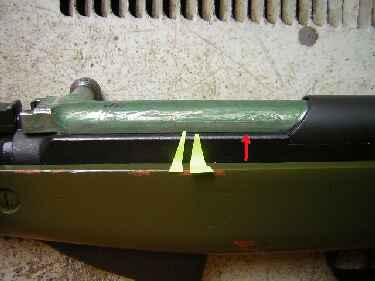 This picture shows why. (For those following this series of SKS articles, the carrier now has a ragged coat of OD green paint applied with a Q-tip.)
This picture shows why. (For those following this series of SKS articles, the carrier now has a ragged coat of OD green paint applied with a Q-tip.)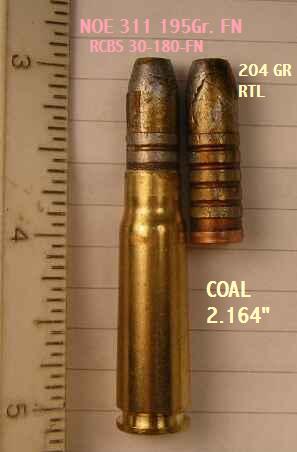 So I ordered an aluminum
So I ordered an aluminum 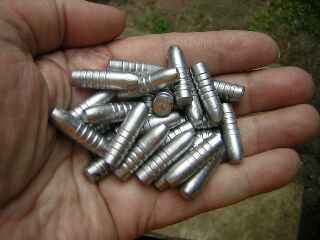 Here's a handful of those air cooled, reclaimed shot alloy
Here's a handful of those air cooled, reclaimed shot alloy 